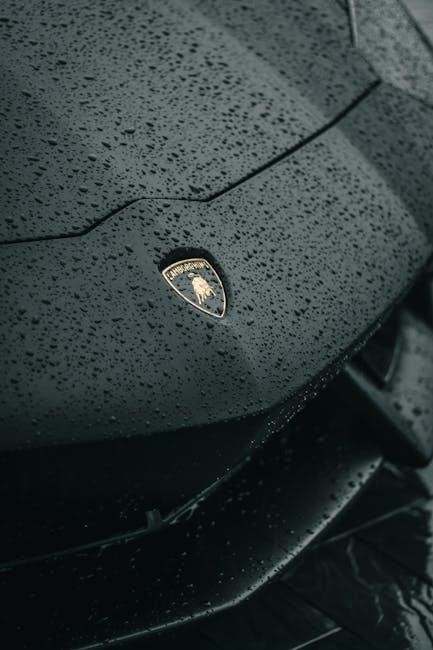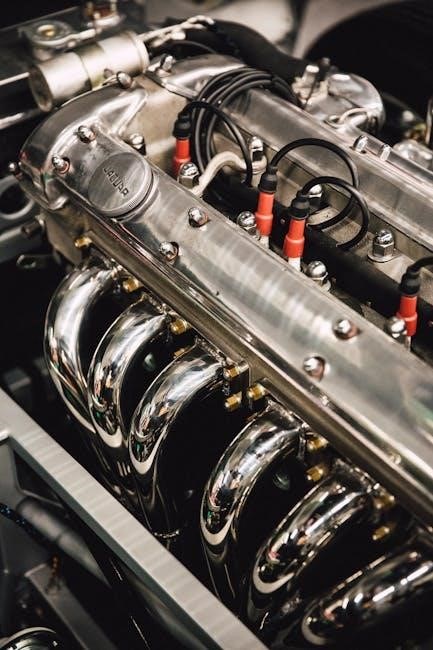Car detailing guide provides expert tips and tricks for cleaning and maintaining vehicles, including interior and exterior detailing methods, using various equipment and supplies, with step-by-step instructions and recommendations․
Importance of Car Detailing
Car detailing is essential for maintaining the overall appearance and condition of a vehicle, as it helps to protect the car’s paint, interior, and exterior components from damage and wear․ Regular detailing can also help to prevent the buildup of dirt, dust, and other substances that can cause damage to the car’s surfaces․ Additionally, car detailing can help to improve the car’s resale value, as a well-maintained vehicle is more attractive to potential buyers․ Furthermore, detailing can also help to identify and address any potential issues with the car, such as scratches, dents, or other forms of damage, before they become major problems․ By investing in regular car detailing, car owners can help to extend the life of their vehicle and keep it looking its best․ This can also give car owners a sense of pride and satisfaction in their vehicle․

Preparation for Car Detailing
Prepare necessary equipment and supplies, including cleaning solutions and tools, to ensure a successful detailing process, following a checklist for efficiency and effectiveness always․
Gathering Necessary Equipment and Supplies
To start the car detailing process, it is essential to gather all the necessary equipment and supplies․ This includes a variety of cleaning solutions, such as glass cleaner, tire cleaner, and leather conditioner․ Additionally, a range of tools like brushes, scrubbers, and microfiber cloths are required․ A vacuum cleaner and a pressure washer may also be needed for more thorough cleaning․ It is crucial to choose the right equipment and supplies to ensure the best results and to avoid damaging the vehicle’s surfaces․ A bucket, hose, and drying towels are also essential for washing and drying the car․ By having all the necessary equipment and supplies, car owners can ensure a successful and efficient detailing process․ The equipment and supplies should be of high quality and suitable for the specific tasks at hand․ This will help to achieve a professional-looking finish and protect the vehicle’s surfaces from damage․

Exterior Car Detailing
Exterior detailing involves cleaning and protecting the car’s exterior surfaces, including paint, windows, and wheels, using various techniques and products, with attention to detail and quality results always․
Proper Washing Techniques
Proper washing techniques are essential for maintaining a car’s exterior appearance and protecting its surfaces from damage․ Using a pH-neutral car cleaner and a soft, microfiber wash mitt can help prevent scratches and swirl marks․ It is also important to avoid washing a car in direct sunlight or on a hot surface, as this can cause soap and water spots to form․ Instead, wash the car in a shaded area or on a cloudy day․ Regular washing can help remove dirt and debris that can damage the car’s paint and clear coat over time․ Additionally, using a two-bucket washing method can help prevent dirt and debris from being redeposited onto the car’s surface․ By following these proper washing techniques, car owners can help keep their vehicle looking its best and maintain its value․ Regular washing is an important part of a car detailing guide․
Cleaning the Wheels and Tires
Cleaning the wheels and tires is a crucial step in the car detailing process․ Using a wheel cleaner and a soft-bristled brush, owners can remove brake dust and grime that can damage the wheels over time․ The tires should also be cleaned with a mild soap and water solution to remove dirt and debris․ A tire dressing can be applied to the tires to give them a shiny appearance and protect them from cracking․ It is also important to clean the wheel wells and lug nuts to remove any dirt or debris that may have accumulated․ By cleaning the wheels and tires, car owners can help improve the overall appearance of their vehicle and maintain its value․ Regular cleaning can also help prevent damage to the wheels and tires, which can be costly to repair․ A car detailing guide can provide more information on the best methods for cleaning wheels and tires․

Interior Car Detailing
Interior car detailing involves cleaning and restoring interior surfaces, including seats, carpets, and dashboards, to maintain a clean and comfortable environment, using various techniques and products, every day․
Vacuuming and Cleaning the Interior
Vacuuming and cleaning the interior is a crucial step in the car detailing process, it involves removing dirt, dust, and debris from the interior surfaces, including the seats, carpets, and floor mats․ This is typically done using a vacuum cleaner and various cleaning products, such as upholstery cleaners and glass cleaners․ The goal is to leave the interior looking and feeling clean and fresh․ It’s also important to pay attention to detail, including cleaning hard-to-reach areas, such as between the seats and under the dashboard․ By using the right techniques and products, you can effectively remove dirt and stains, and leave the interior of your car looking like new․ Regular vacuuming and cleaning can also help to prevent the buildup of dirt and dust, and keep your car’s interior looking its best․ This helps to maintain a clean and comfortable environment․
Carpet Shampooing and Upholstery Cleaning
Carpet shampooing and upholstery cleaning are essential steps in deep cleaning the interior of a vehicle․ This process involves using specialized equipment and cleaning solutions to remove dirt, stains, and odors from the carpets and upholstery․ The goal is to restore the original appearance and freshness of the interior surfaces․ A drill brush can be used to agitate the carpet and work the shampoo into the fibers, while a wet vacuum is used to extract the dirt and cleaning solution․ For upholstery, a gentle cleaning product and a soft-bristled brush are used to clean delicate surfaces․ Regular carpet shampooing and upholstery cleaning can help to prevent the buildup of dirt and stains, and keep the interior of the car looking and smelling its best․ By following the right techniques and using the right equipment, you can achieve professional-looking results and extend the life of your car’s interior․ This process requires patience and attention to detail․

Additional Tips and Tricks
Expert car detailers share tips and tricks for achieving professional results, using specialized equipment and techniques to enhance the appearance and longevity of vehicles, with step-by-step instructions online․
Working from Top to Bottom
When detailing a car, it is essential to work from top to bottom to prevent dirt and debris from spreading to clean areas․ This method involves starting with the roof, then moving on to the trunk, hood, and finally the wheels and tires․ By following this approach, detailers can ensure that the entire vehicle is cleaned thoroughly and efficiently․ The process begins with vacuuming the headliner, dash, console, and door panels, followed by cleaning the windows, mirrors, and other exterior surfaces․ Next, the detailer moves on to the paintwork, using a combination of washing, polishing, and waxing to achieve a showroom shine․ Finally, the wheels and tires are cleaned and dressed to complete the detailing process․ By working from top to bottom, car owners can maintain their vehicle’s appearance and protect its surfaces from damage․ This technique is widely recommended by car care experts and is an essential part of any car detailing guide․
Avoiding Direct Sunlight and Heat
Avoiding direct sunlight and heat is crucial when detailing a car, as it can cause damage to the paintwork and other surfaces․ The heat can also speed up the drying process of detailing products, reducing their effectiveness․ To avoid this, detailers should work in a shaded area or use a canopy to provide shade․ If this is not possible, it is recommended to detail the car early in the morning or late in the evening when the sun is not too strong․ Additionally, detailers should use products that are specifically designed to work in high temperatures․ By avoiding direct sunlight and heat, car owners can ensure that their vehicle’s surfaces are protected and the detailing process is effective․ This technique is essential for achieving a showroom shine and maintaining the car’s appearance․ Proper care and attention to detail can make a significant difference in the overall outcome of the detailing process․
